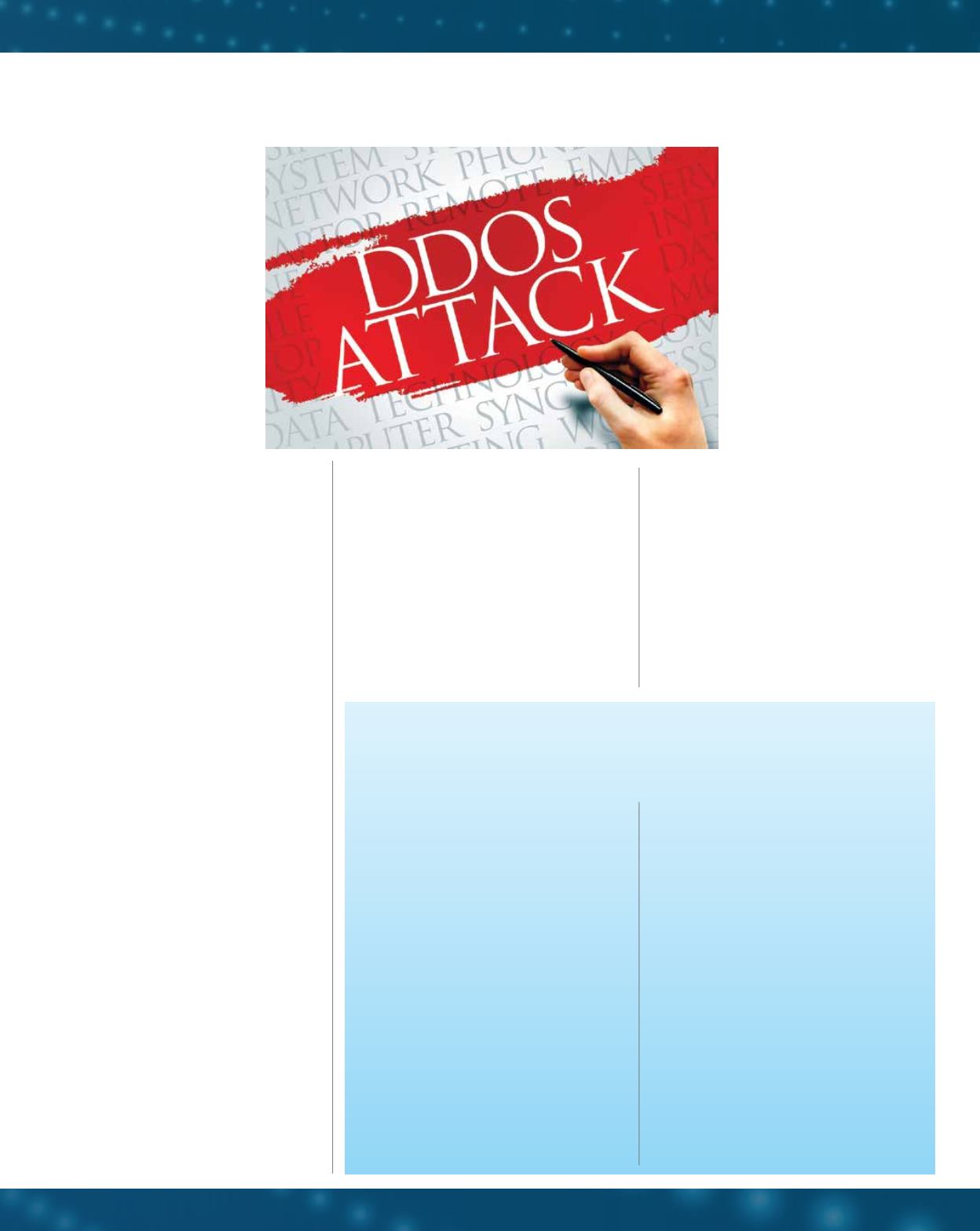

COMPTEL PLUS Fall 2015 Business Expo
Beka Publishing,
www.bekapublishing.comCOMPTELPlus
|
Tuesday, October 20, 2015
29
DAY 2
R
ecognizing the ongoing and
increasing threats from distrib-
uted denial of service (DDoS)
attacks, NTT Com is highlighting its
DDoS Protection Service at COMPTEL
PLUS. This service allows for fast and
effective actions to minimize the
impact of a hit.
Cybersecurity remains at the top
of the headlines, with world leaders
and network engineers alike talking
about its risks and remedies. But while
any organization with an online pres-
ence is a potential target for a DDoS
attack, many organizations have inad-
equate security strategies in place for
defending against such a threat.
There is no single strategy to
defend against today’s sophisticated
and evolving DDoS threat landscape. Instead,
a layered defense approach – which combines
traditional security measures, vast availability of
bandwidth, intelligent DDoS mitigation systems
and sound risk management strategies – is recom-
mended. NTT Com has deployed technologies to
aid in the effort, built upon DDoS protection plat-
forms, NTT Com’s global Tier-1 IP network and 24x7
expert monitoring services.
One of the most common types of online
threats, a DDoS attack is an attempt to make a
network resource unavailable by interrupting or
suspending services of a host connected to the
Internet, usually by overwhelming it with bogus
traffic flows. These attacks can strike at any time,
potentially crippling network infrastructure and
severely degrading user experience.
When notified of a possible attack, NTT Com’s
dedicated network security team analyzes key
network data to confirm whether an attack is in
progress, and then rapidly re-directs incoming
traffic through the mitigation platform. The
DDoS Protection Service platform is built on
best-of-breed technology, which removes attack
traffic and passes legitimate “clean” traffic onto a
network, allowing businesses to stay online and
function during the attack.
A recent report by Akamai found that the
number of DDoS attacks in the second quarter of
2015 increased 132 percent compared with the
same period last year. The study also said that
the average DDoS attack lasted nearly 21 hours.
Those 21 hours are hours during which customers
can’t shop online, pay their bills or check e-mail—
which directly affects a company’s bottom line.
Depending upon the type and severity of the
attack, the impact might also result in resource
damages, decreased productivity and irreparable
harm to a company’s brand.
Early DDoS attacks were focused primarily on
flooding network resources with unwanted traffic
so that legitimate traffic would be unable to reach
the intended target. More recently, application
layer attacks designed to compromise a specific
service on a host have become more prevalent.
Because application layer attack traffic looks similar
to legitimate traffic, traditional security measures,
such as filtering, firewalls and intrusion detection
and protection systems are not sufficient defenses.
In addition, attackers are learning from the
defending countermeasures being used and adjusting
their attacks towards other targets and vulnerabilities.
The motivations of attackers
can range from social and political
protests—“hacktivism”—to finan-
cial extortion with the intent to
disrupt governments, organiza-
tions or businesses. In many cases
DDoS attacks are the cover for other
hacking crimes, such as property,
fund or data thefts.
Recent political instability and
unrest in the Middle East, Ukraine
and Africa saw corresponding spikes
in DDoS attacks on regional busi-
nesses and governments. Often,
websites dedicated to reporting
abuses or censorship become
targets of DDoS attacks as well.
Internet-centric businesses,
online retailers and e-commerce
websites are especially vulnerable even, if
they have some DDoS mitigation tools in
place. However, insufficient budget resources,
a shortage of qualified personnel, and a lack
of C-level support are still critical barriers to
preventing and mitigating attacks, a report from
the Ponemon Institute found.
“NTT Com offers the technology, experience
and flexibility that competitive telecommunica-
tions providers need to design and implement
a comprehensive and successful DDoS defense
strategy,” the company said.
o
NTT Com DDoS Protection Helps Mitigate Cyber-Attacks
E
quinox (Booth 703) has announced that it is
now an employee-owned business.
Under a fresh structure, Equinox
employees have stock ownership in the company,
with allocations based on performance and tenure,
where one’s ownership percentage increases
according to years of service, until retirement.
The company’s transition to an employee
stock ownership plan (ESOP) fulfills the vision of
founders Wayne Lowe and Byron Middendorf,
the company said, which was to “create a great
place to work.”
“Wayne and I realize that Equinox’s success in
the market is directly tied to customer satisfac-
tion, which is, of course, fueled by happy, well-
tended employees,”Middendorf, the company’s
CEO. “In thinking about how to further take care
of our employees, instituting an ESOP just felt like
the next natural step.”
Since its inception in 1986, Equinox has
focused on helping telecom customers stop
fraud, mediate usage data, manage expenses and
optimize revenue. Based on the company’s reach
and experience across virtually every sector of
the telecom industry around the globe, including
cable telephony, wireline, wireless, rural inde-
pendent, CLEC, and wholesale providers, Lowe
said that there’s no doubt that this model works,
benefitting employees and customers alike.
“It was very rewarding to present the new
ownership structure and initial stock distribu-
tion earlier this year,” added Lowe, the compa-
ny’s president. “Transitioning [employees]
to stakeholders is a tangible way to thank
employees for their years of dedicated work,
and it also has exciting implications for our
customers. Shared ownership is a catalyst for
innovation and collaborative company expense
management. In fact, data from national studies
shows that employee-owned companies
demonstrate improved performance over non-
ESOPs. We are all excited about the future.”
o
Equinox Transitions to New
Employee-Owned Structure
















